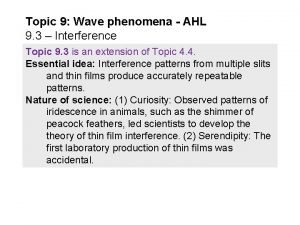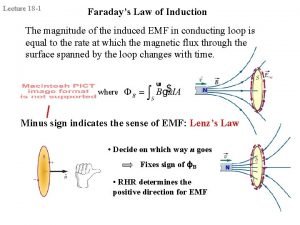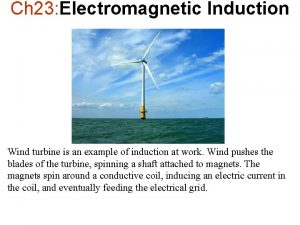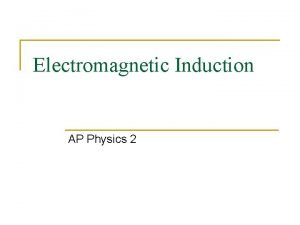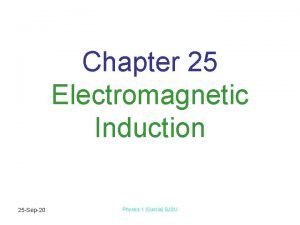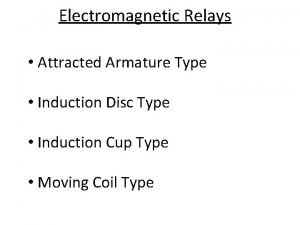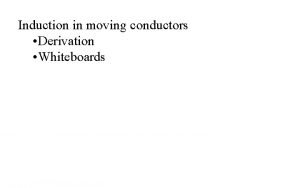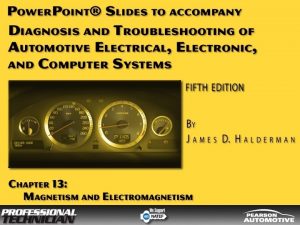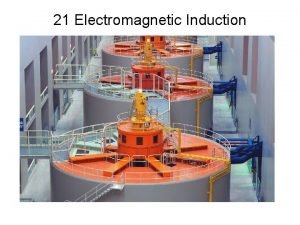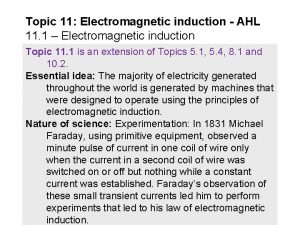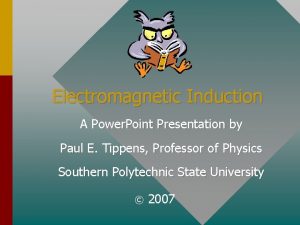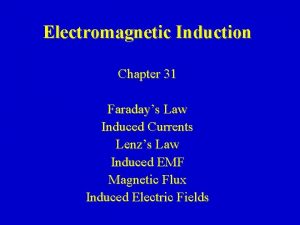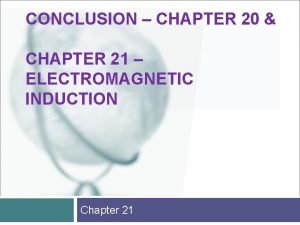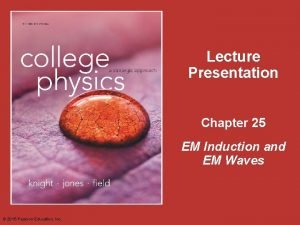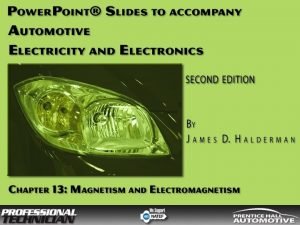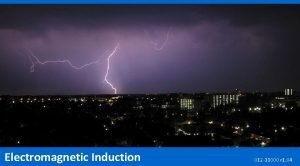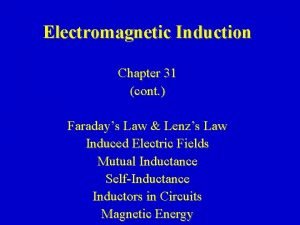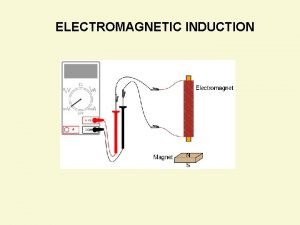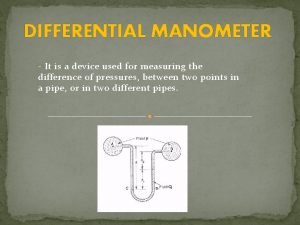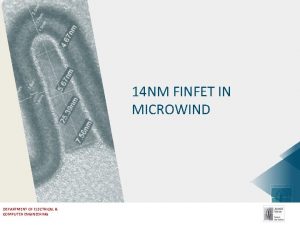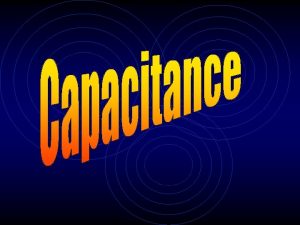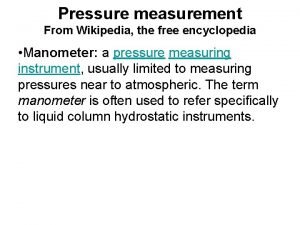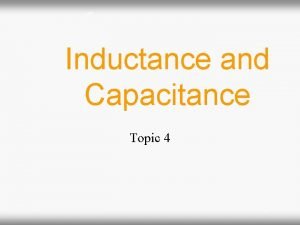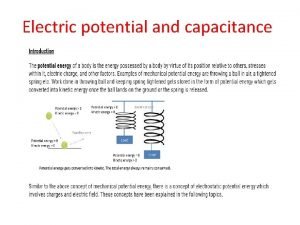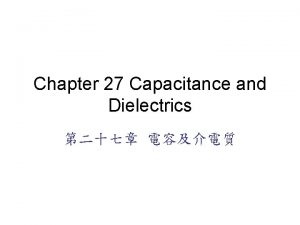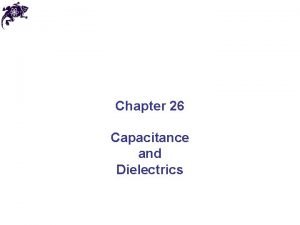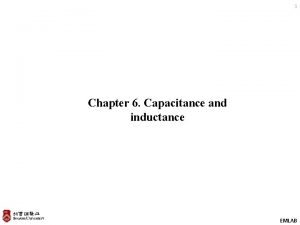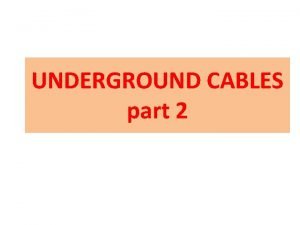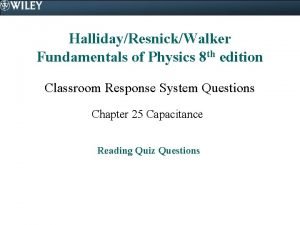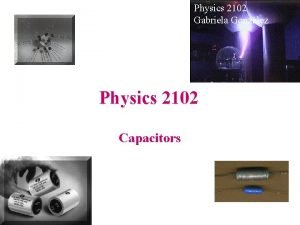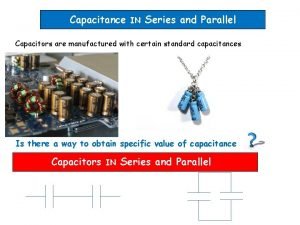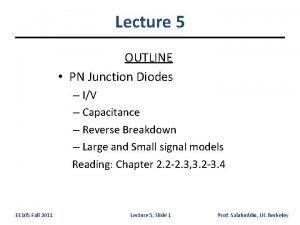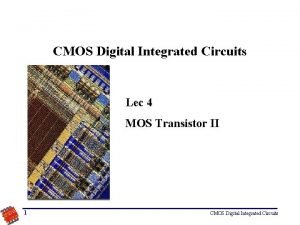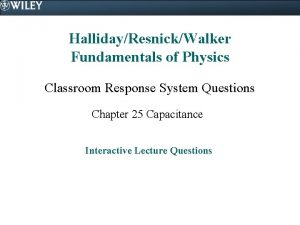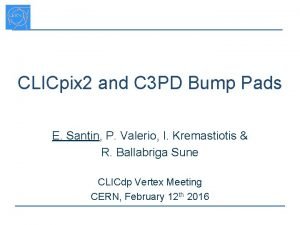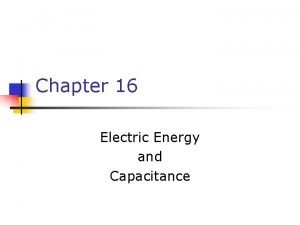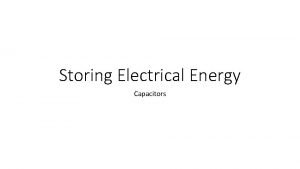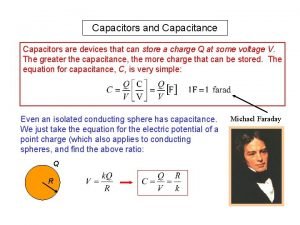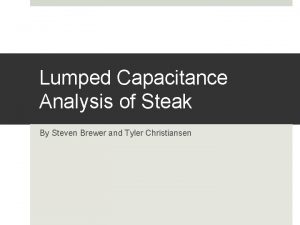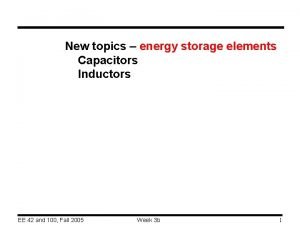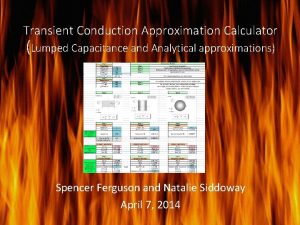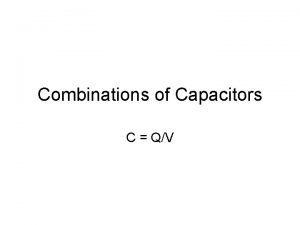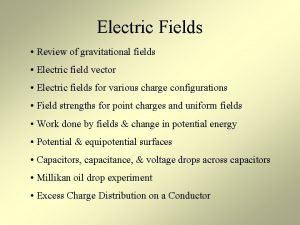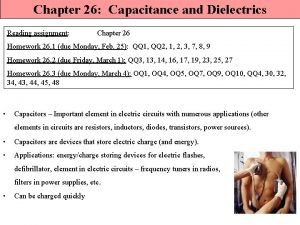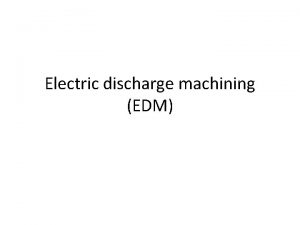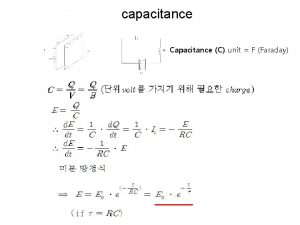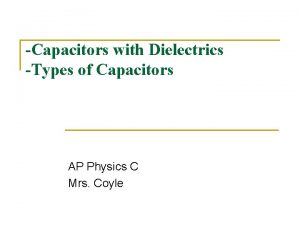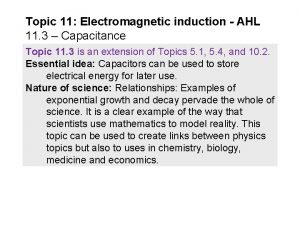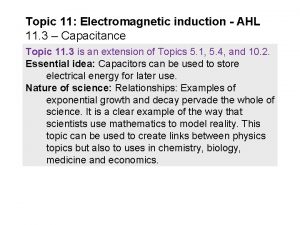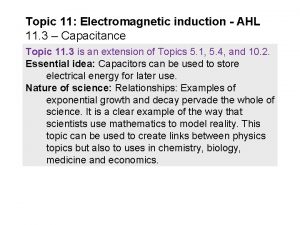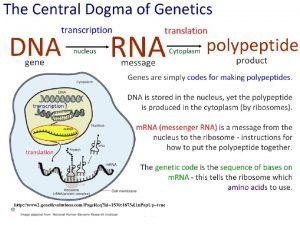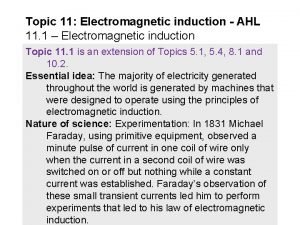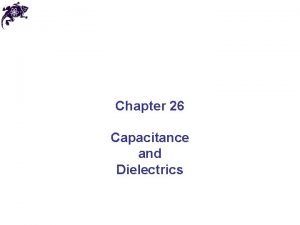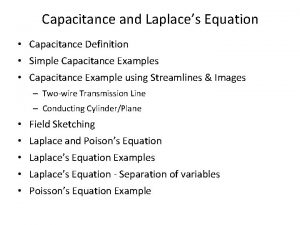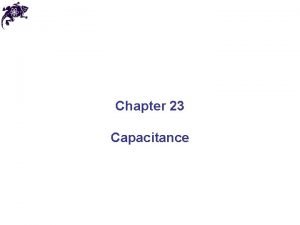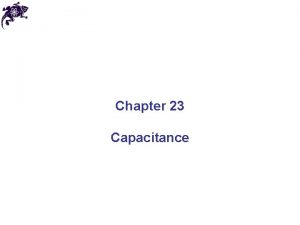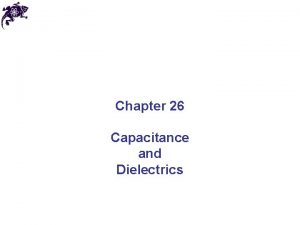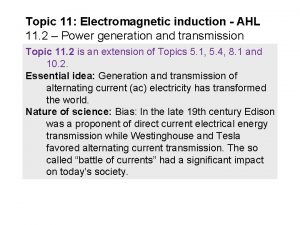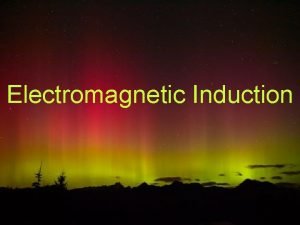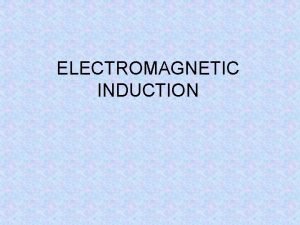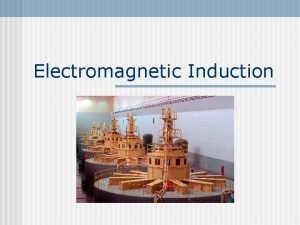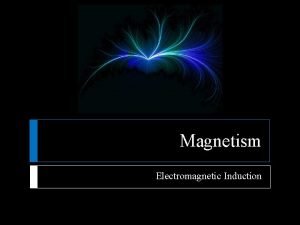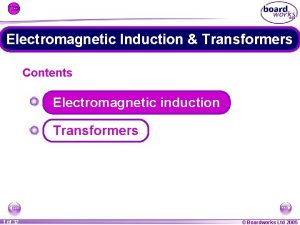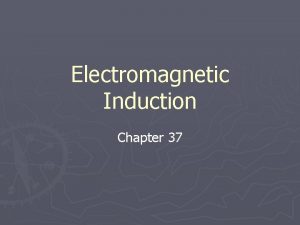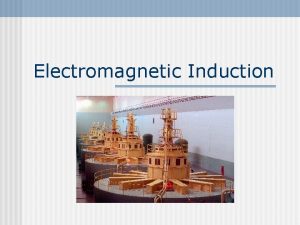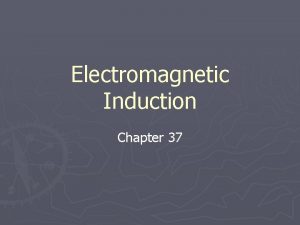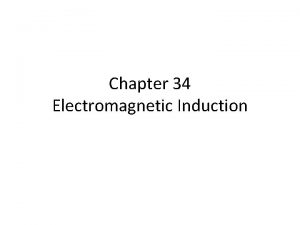Topic 11 Electromagnetic induction AHL 11 3 Capacitance


















































- Slides: 50

Topic 11: Electromagnetic induction - AHL 11. 3 – Capacitance Topic 11. 3 is an extension of Topics 5. 1, 5. 4, and 10. 2. Essential idea: Capacitors can be used to store electrical energy for later use. Nature of science: Relationships: Examples of exponential growth and decay pervade the whole of science. It is a clear example of the way that scientists use mathematics to model reality. This topic can be used to create links between physics topics but also to uses in chemistry, biology, medicine and economics.

Topic 11: Electromagnetic induction - AHL 11. 3 – Capacitance Understandings: • Capacitance • Dielectric materials • Capacitors in series and parallel • Resistor-capacitor (RC) series circuits • Time constant

Topic 11: Electromagnetic induction - AHL 11. 3 – Capacitance Applications and skills: • Describing the effect of different dielectric materials on capacitance • Solving problems involving parallel-plate capacitors • Investigating combinations of capacitors in series or parallel circuits • Determining the energy stored in a charged capacitor • Describing the nature of the exponential discharge of a capacitor • Solving problems involving the discharge of a capacitor through a fixed resistor • Solving problems involving the time constant of an RC circuit for charge, voltage and current

Topic 11: Electromagnetic induction - AHL 11. 3 – Capacitance Guidance: • Only single parallel-plate capacitors providing a uniform electric field, in series with a load, need to be considered (edge effect will be neglected) • Problems involving the discharge of capacitors through fixed resistors need to be treated both graphically and algebraically • Problems involving the charging of a capacitor will only be treated graphically • Derivation of the charge, voltage and current equations as a function of time is not required

Topic 11: Electromagnetic induction - AHL 11. 3 – Capacitance Data booklet reference: • C=q/V • Cparallel = C 1 + C 2 + … • 1 / Cseries = 1 / C 1 + 1 / C 2 + … • C = A / d • E = (1/2) CV 2 • = RC • q = q 0 e –t / • I = I 0 e –t / • V = V 0 e –t /

Topic 11: Electromagnetic induction - AHL 11. 3 – Capacitance International-mindedness: • Lightning is a phenomenon that has fascinated physicists from Pliny through Newton to Franklin. The charged clouds form one plate of a capacitor with other clouds or Earth forming the second plate. The frequency of lightning strikes varies globally, being particularly prevalent in equatorial regions. The impact of lightning strikes is significant with many humans and animals being killed annually and huge financial costs to industry from damage to buildings, communication and power transmission systems, and delays or the need to reroute air transport.

Topic 11: Electromagnetic induction - AHL 11. 3 – Capacitance Utilization: • The charge and discharge of capacitors obeys rules that have parallels in other branches of physics including radioactivity (see Physics sub-topic 7. 1)

Topic 11: Electromagnetic induction - AHL 11. 3 – Capacitance Aims: • Aim 3: the treatment of exponential growth and decay by graphical and algebraic methods offers both the visual and rigorous approach so often characteristic of science and technology • Aim 6: experiments could include (but are not limited to): investigating basic RC circuits; using a capacitor in a bridge circuit; examining other types of capacitors; verifying time constant Essential idea: Generation and transmission of alternating current (ac) electricity has transformed the world.

Topic 11: Electromagnetic induction - AHL 11. 3 – Capacitance A capacitor is an electronic device that stores charge. In its simplest form, it is made up of two separated parallel plates. In between the plates we can have air, vacuum, or a non-conductive material called a dielectric. Although there are other types of capacitors, in this topic we will study the parallel plate capacitor. Its schematic is shown here, and is comprised of two parallel lines. An electrolytic capacitor has a higher capacity than a parallel plate capacitor.

Topic 11: Electromagnetic induction - AHL 11. 3 – Capacitance We define the capacitance C to be the charge q per unit voltage V which the capacitor is capable of maintaining. C=q/V definition of capacitance The units for capacitance are Coulombs per volt which are called farads and abbreviated F. EXAMPLE: A 1. 50 -V cell is connected to a 275 F capacitor in the circuit shown. How much charge is stored on the capacitor’s plates? SOLUTION: Use C = q / V q = CV = 275 10 -6 1. 50 = 4. 13 10 -4 C. FYI Don’t confuse C (capacitance) with C (Coulombs).

Topic 11: Electromagnetic induction - AHL 11. 3 – Capacitance – parallel V C 1 C 2 Just as we connected resistors in parallel, so too can we connect capacitors. Because the capacitors are in parallel, they each have the cell’s voltage V. Thus V = V 1 = V 2. From C = q / V we get q = CV. Thus q = CV, q 1 = C 1 V 1 , and q 2 = C 2 V 2. Conservation of charge tells us that q = q 1 + q 2: CV = C 1 V 1 + C 2 V 2 a variable capacitor CV = C 1 V + C 2 V takes advantage of C = C 1 + C 2 many parallel plates… C = C 1 + C 2 + … parallel capacitance

Topic 11: Electromagnetic induction - AHL 11. 3 – Capacitance – parallel V C 1 EXAMPLE: A 1. 50 -V cell is connected to C 1 = 275 F and C 2 = 38 F in the circuit. (a) What value should a single replacement capacitor have? SOLUTION: The capacitors are in parallel. C = C 1 + C 2 = 275 10 -6 + 38 10 -6 = 303 10 -6 F. (b) How much charge has the battery placed on the capacitors? SOLUTION: q = CV = 303 10 -6 1. 50 = 455 10 -6 C. C 2

Topic 11: Electromagnetic induction - AHL 11. 3 – Capacitance – series V We can also connect capacitors in series: Because the capacitors are in series, C 1 they each have the same charge q. Thus q = q 1 = q 2. From C = q / V we get V = q / C. Thus V = q / C, V 1 = q 1 / C 1 , and V 2 = q 2 / C 2. Conservation of energy tells us that V = V 1 + V 2 so that q / C = q 1 / C 1 + q 2 / C 2 1 / C = 1 / C 1 + 1 / C 2 + … series capacitance FYI Note that the series/parallel formulas for capacitance are reversed from those for resistance! C 2

Topic 11: Electromagnetic induction - AHL 11. 3 – Capacitance – series V EXAMPLE: A 1. 50 -V cell is connected to C 1 = 275 F and C 2 = 38 F in the circuit. (a) What value should a single replacement C 1 capacitor have? SOLUTION: The capacitors are in series. 1 / C = 1 / C 1 + 1 / C 2 = 1 / 275 10 -6 + 1 / 38 10 -6 = 29952. 2. C = 1 / 29952. 2 = 3. 34 10 -5 F. (b) How much charge has the battery placed on each capacitor? What are their voltages? Note that VCi = V. SOLUTION: Series capacitors have the same charge. q = CV = 3. 34 10 -5 1. 50 = 5. 01 10 -5 C. V 1 = q 1 / C 1 = 5. 01 10 -5 / 275 10 -6 = 0. 18 V. V 2 = q 2 / C 2 = 5. 01 10 -5 / 38 10 -6 = 1. 32 V. C 2

Topic 11: Electromagnetic induction - AHL 11. 3 – Capacitance Dielectric materials A simple capacitor consists of + + + two conductors separated by –––––– non-conductive space. Thus, even the wires in an electronic circuit have capacitance. In extremely high frequency circuits this inter-wire capacitance may cause problems and must be minimized through proper design. Capacitors are, however, used in most electronics devices, and large capacity in small space is the premium. Capacitors are used as filters, coupling devices, voltage smoothing (as in the full-wave rectifier), and timing devices.

Topic 11: Electromagnetic induction - AHL 11. 3 – Capacitance Dielectric materials When capacitance is desired, large capacity in a small space is the premium. In order to increase the ability of a capacitor to store charge, we use conductive plates instead of wires. There are two ways to increase the capacitance. 1: Increase the area over which charge can be stored (thus the like charges can d “spread out” and chill in their A own personal space). 2: Decrease the distance between the plates (thus the charges on the opposite plates attract even more to each other, making it easier for the cell to “pump” charge into the device).

Topic 11: Electromagnetic induction - AHL 11. 3 – Capacitance Dielectric materials Because the attractive force between charges is, by Coulomb’s law, F = kq 1 q 2 / d 2, we see that it grows exponentially with decreasing plate separation d. Charge leakage can occur through air or vacuum. So what manufacturers do is they place a non-conductive material called a dielectric between the plates. This will both reduce arcing and the dielectric force, increasing the capacity of the capacitor. C = A / d parallel-plate capacitor The epsilon is the permittivity of the dielectric. Recall that the permittivity of free space (and air) is = 8. 85 10 -12 F m-1.

Topic 11: Electromagnetic induction - AHL 11. 3 – Capacitance Dielectric materials What a dielectric material does is it essentially reduces the electric field by the ratio 0 / . The way it does this is that the molecules in the dielectric material are polarized in response to the electric field of the plates, and create an oppositely-oriented electric field. This dielectric field cancels some of the original field, thereby diminishing the overall E-field between the plates. From q = CV and recalling from 10. 2 that V = Ed, we see that q / C = V = Ed so that C = q / Ed. This tells us that the smaller the electric field is, the larger the capacitance.

Topic 11: Electromagnetic induction - AHL 11. 3 – Capacitance Dielectric materials EXAMPLE: A 275 F capacitor will be manufactured using a dielectric having a permittivity of 4. 00 0 and circular plates having a diameter of 2. 50 cm. What should the plate separation (and the thickness of the dielectric) be? Is it likely that this large a capacity could be constructed using parallel plate architecture? SOLUTION: Use C = A / d. The area in the formula is the area of one plate. A = d 2/ 4 = (2. 50 10 -2)2 / 4 = 4. 909 10 -4 m 2. d = A / C = 4. 00 8. 85 10 -12 4. 909 10 -4 / 275 10 -6 = 6. 32 10 -11 m. Given that the plate separation is of the order of an atomic diameter, it is very unlikely that one could construct a 275 F parallel plate capacitor.

Topic 11: Electromagnetic induction - AHL 11. 3 – Capacitance Energy stored in a capacitor From the relationship C = q / V we can write V = (1 / C) q. We see, then, that the graph of V vs. q V is a straight line having a slope of (1 / C): Recall that the work done by a cell is given by W = q. V, provided V and q are constant. If they are not constant, W = area under the V vs. q graph. Since the area of a triangle is (1/2) bh we have W = (1/2)q. V. From conservation of energy, this is then the energy stored in a capacitor. E = (1/2)q. V = (1/2)CV 2 energy stored in a capacitor q

Topic 11: Electromagnetic induction - AHL 11. 3 – Capacitance Energy stored in a capacitor E = (1/2)q. V = (1/2)CV 2 energy stored in a capacitor PRACTICE: On the previous slide it was shown that the energy stored in a capacitor is E = (1/2)q. V. Show that the energy stored in a capacitor is also given by E = (1/2)CV 2. Then, find the energy stored in a 275 F capacitor charged up to 1. 50 V. SOLUTION: Use the definition of capacitance C = q / V. Then q = CV so that E = (1/2)q. V = (1/2)(CV)V = (1/2)CV 2. Finally, E = (1/2)CV 2 = (1/2) 275 10 -6(1. 502) = 3. 09 10 -4 J.

Topic 11: Electromagnetic induction - AHL 11. 3 – Capacitance Solving problems involving parallel-plate capacitors EXAMPLE: Two capacitors are in the circuit shown. C 1 is fully charged at 1. 50 V, and C 2 is initially uncharged. (a) What is the electrical energy stored in C 1? (b) What is the charge on C 1’s plates? SOLUTION: (a) E = (1/2)CV 2 = 3. 09 10 -4 J (see previous slide). (b) q = CV = 275 10 -6(1. 50) = 4. 125 10 -4 C.

Topic 11: Electromagnetic induction - AHL 11. 3 – Capacitance Solving problems involving parallel-plate capacitors EXAMPLE: Two capacitors are in the circuit shown. C 1 is fully charged at 1. 50 V, and C 2 is initially uncharged. (c) When the switch is closed, what will the charge on C 1 be? What charge will C 2 have? SOLUTION: The capacitors are in parallel. Thus V 1 = V 2 q 1 / C 1 = q 2 / C 2. Thus q 2 = ( C 2 / C 1 )q 1. From conservation of charge, q 1 + q 2 = 4. 125 10 -4 C. 4. 125 10 -4 = q 1 + q 2 = q 1 + ( C 2 / C 1 )q 1. = q 1 ( 1 + 38 / 275 ) q 1 = 3. 62 10 -4 C. 3. 62 10 -4 + q 2 = 4. 125 10 -4 q 2 = 5. 01 10 -5 C.

Topic 11: Electromagnetic induction - AHL 11. 3 – Capacitance Solving problems involving parallel-plate capacitors EXAMPLE: A capacitor having no dielectric has a capacitance of 325 p. F. It is charged up to 6. 00 V by momentarily attaching it to a battery, and then disconnecting it. (a) What is the energy stored in the capacitor at this voltage? (b) What is the charge on the capacitor? SOLUTION: (a) E = (1/2)CV 2 = (1/2) 325 10 -12 6. 002 = 5. 85 10 -9 J. (b) q = CV = 325 10 -12 6. 00 = 1. 95 10 -9 C.

Topic 11: Electromagnetic induction - AHL 11. 3 – Capacitance Solving problems involving parallel-plate capacitors EXAMPLE: A capacitor having no dielectric has a capacitance of 325 p. F. It is charged up to 6. 00 V dielectric by momentarily attaching it to a battery, and then disconnecting it. (c) A dielectric having a permittivity of 2 0 is now carefully inserted between the plates of the capacitor. What is its new capacitance? SOLUTION: Use C = A / d. (c) C 0 = 0 A / d and C = (2 0)A / d so that C = 2 C 0 = 2(325 p. F) = 650. p. F.

Topic 11: Electromagnetic induction - AHL 11. 3 – Capacitance Solving problems involving parallel-plate capacitors EXAMPLE: A capacitor having no dielectric has a capacitance of 325 p. F. It is charged up to 6. 00 V dielectric by momentarily attaching it to a battery, and then disconnecting it. (d) What is the charge on the new capacitor? (e) What is the voltage on the new capacitor? SOLUTION: Conservation of (d) The charge does not change. Why? charge. Thus q = 1. 95 10 -9 C. (e) From q = CV we see that V = q / C = 1. 95 10 -9 / 650 10 -12 = 3. 00 V.

Topic 11: Electromagnetic induction - AHL 11. 3 – Capacitance Solving problems involving parallel-plate capacitors EXAMPLE: A capacitor having no dielectric has a capacitance of 325 p. F. It is charged up to 6. 00 V dielectric by momentarily attaching it to a battery, and then disconnecting it. (f) What is the energy stored in the new capacitor? (g) Explain the discrepancy between (f) and (a). SOLUTION: (f) Use either E = (1/2)CV 2 or E = (1/2)q. V: E = (1/2)q. V = (1/2) 1. 95 10 -9 3. 00 = 2. 93 10 -9 J. (g) This is half the energy stored in the capacitor without the dielectric. The dielectric would be attracted into the void: The “inserter” would have to do negative work!

Topic 11: Electromagnetic induction - AHL 11. 3 – Capacitance Solving problems involving parallel-plate capacitors Charge can be neither created nor destroyed. + ++ ++ It can be separated into (+) and (-) in equal quantities. The (-) was separated from the ground, leaving behind an equal amount of (+).

Topic 11: Electromagnetic induction - AHL 11. 3 – Capacitance Solving problems involving parallel-plate capacitors + ++ ++ The electric field strength E at any point in space is equal to the force per unit charge at that point. If in doubt, find the applicable formula and translate it into words. “E = F / q. ”

Topic 11: Electromagnetic induction - AHL 11. 3 – Capacitance Solving problems involving parallel-plate capacitors + ++ ++ Just recall that between parallel plates the E-field is uniform (equally spaced), and it points from (+) toward (-).

Topic 11: Electromagnetic induction - AHL 11. 3 – Capacitance Solving problems involving parallel-plate capacitors = q / A = 20 C / 7 106 m 2 = 2. 86 10 -6 C m-2. 0 = 8. 85× 10 -12 C 2 N-1 m− 2 (from Data Booklet). Then E = / 0 = 2. 86 10 -6 / 8. 85× 10 -12 = 3× 105 Vm-1.

Topic 11: Electromagnetic induction - AHL 11. 3 – Capacitance Solving problems involving parallel-plate capacitors is the same everywhere on the cloud. 0 is the same in air as in free space. The ground and the cloud’s lower surface are flat and parallel.

Topic 11: Electromagnetic induction - AHL 11. 3 – Capacitance Solving problems involving parallel-plate capacitors Use E = -∆V / ∆r and ignore the sign: Then ∆V = E ∆r = (3× 105)(500) = 1. 5 108 V!

Topic 11: Electromagnetic induction - AHL 11. 3 – Capacitance Solving problems involving parallel-plate capacitors I = q / t = 20 C / 20 10 -3 s = 1000 A. ∆EP = q∆V = (20)(1. 5 108) = 3 109 J. Or…P = IV = (1000)(1. 5 108) = 1. 5 1011 W. E = Pt = (1. 5 1011)(20 10 -3) = 3 109 J.

Topic 11: Electromagnetic induction - AHL 11. 3 – Capacitance V/V Charging a capacitor PRACTICE: A 1. 50 -V cell is connected to a 275 F capacitor in the circuit shown. (a) Make a sketch graph of what the voltmeter reads after the switch is closed. SOLUTION: 1. 50 Before the switch is closed the voltage on the capacitor is zero. After the switch is closed, the voltage will increase from zero to 1. 50 V in a very short amount of time as the plates store the charge. Then the capacitor’s voltage will remain at 1. 50 V. t

Topic 11: Electromagnetic induction - AHL 11. 3 – Capacitance I/A Charging a capacitor PRACTICE: A 1. 50 -V cell is connected to a 275 F capacitor in the circuit shown. (b) Make a sketch graph of what the ammeter reads after the switch is closed. SOLUTION: MAX Before the switch is closed the current is zero. After the switch is closed, the t current will begin at a maximum value and will decrease rapidly as the plates “fill up” with charge and repel further charge. Then the current will remain at zero.

Topic 11: Electromagnetic induction - AHL 11. 3 – Capacitance q/C Charging a capacitor PRACTICE: A 1. 50 -V cell is connected to a 275 F capacitor in the circuit shown. (c) Make a sketch graph of the charge q on the plates after the switch is closed. SOLUTION: MAX Before the switch is closed the charge is zero. After the switch is closed, the charge will rapidly “fill up” the plates and slow down the subsequent flow due to repulsion. Then the charge will reach a maximum value on the plates, stopping the flow of further charge. t

Topic 11: Electromagnetic induction - AHL 11. 3 – Capacitance I/A RC series circuits – charging R PRACTICE: A 1. 50 -V cell is connected in series to a capacitor and resistor. C Make a sketch graph showing the family of curves representing the voltage across the resistor after the switch is closed as RC increases. SOLUTION: MAX Before the switch is closed the current is zero. After the switch is closed, the current will begin at a maximum value and will decrease rapidly as the plates “fill up” with charge and repel further charge. Then the current will remain at zero. t

Topic 11: Electromagnetic induction - AHL 11. 3 – Capacitance V/V I/A RC series circuits – charging R PRACTICE: A 1. 50 -V cell is connected in series to a capacitor and resistor. C Make a sketch graph showing the family of curves representing the voltage across the resistor after the switch is closed as RC increases. SOLUTION: MAX Because the voltage across the resistor is proportional to the current (V = IR), its graph will have the same shape t as I: 1. 50 Furthermore, the bigger R and high RC medium RC C are, the longer it will take for the capacitor to charge and the current to stop. low RC t

Topic 11: Electromagnetic induction - AHL 11. 3 – Capacitance A B q/C q/Q RC series circuits – discharging PRACTICE: A two-position switch can alternately charge (A) and discharge (B) C + a capacitor C through a resistor R. – R Make sketch graphs of what the charge across the capacitor C reads when the switch is placed (a) at position A, and (b) at position B. q 0 SOLUTION: switch in position (a) When the switch is placed at A to charge A the circuit is connected to the t cell and thus begins to charge. q 0 switch in position (b) When the switch is then B to discharge placed at B, the capacitor begins t to discharge through the wire and the resistor.

Topic 11: Electromagnetic induction - AHL 11. 3 – Capacitance A B RC series circuits – discharging Suppose the capacitor is fully charged. + Then we place the switch to position B – C for discharge: R The (+) on the top plate then travels CW through the wire and the resistor to the bottom plate: If we use Kirchhoff’s rule for V we see that following the loop in the direction of the current we have Vi = 0 VC – IR = 0. But since VC = q / C and since I = q / t we have q / C – R( q / t ) = 0 q / t = – q / RC. The (–) sign on the right hand side shows that q is ALWAYS negative during discharge.

Topic 11: Electromagnetic induction - AHL 11. 3 – Capacitance RC series circuits – discharging We can write the results of the RC discharge thus: I = q / t = – q / q = q 0 e -t / RC where = RC discharge As an aside, and beyond the scope of this course, the exponential form comes from the associated differential equation: dq / dt = – q / . It turns out that q = q 0 e -t / is its time-dependent solution. FYI Many of the formulas we use in IB physics are easily derived using both differential and integral calculus. Although IB requires you to use the resulting formulaic solutions to the differential equations, you do not have to derive them.

Topic 11: Electromagnetic induction - AHL 11. 3 – Capacitance RC series circuits – discharging I = q / t = – q / RC q = q 0 e -t / where = RC discharge We call = RC the time constant, and see that it has the units of seconds (time). EXAMPLE: A 275 F capacitor is charged to 6. 00 V. It is then discharged through a 10. 0 M resistor. (a) Find the time constant. (b) Find the initial charge on the plates. SOLUTION: (a) The time constant is = RC = 10. 0 106 275 10 -6 = 2750 s. (b) q 0 = CV 0 = 275 10 -6 6. 00 = 0. 00165 C.

Topic 11: Electromagnetic induction - AHL 11. 3 – Capacitance RC series circuits – discharging I = q / t = – q / RC q = q 0 e -t / where = RC discharge We call = RC the time constant, and see that it has the units of seconds (time). EXAMPLE: A 275 F capacitor is charged to 6. 00 V. It is then discharged through a 10. 0 M resistor. (c) Find the charge on the plates exactly one time constant after discharge has begun. SOLUTION: (c) Substitute t = and q 0 = 0. 00165 C into q = q 0 e -t / = 0. 00165 e -1 = 0. 00165 / e = 0. 00165 / 2. 7183 = 0. 000607 C. This is 37% of its original charge.

Topic 11: Electromagnetic induction - AHL 11. 3 – Capacitance RC series circuits – discharging I = q / t = – q / RC q = q 0 e -t / where = RC discharge Because of the relationships V = q / C and I = V / R we can derive the next two formulas easily: I = I 0 e -t / where I 0 = q 0 / RC RC and V 0 = q 0 / C discharge V = V 0 e -t / Keep in mind that V = V 0 e -t / is the voltage across the capacitor and not the resistor. The resistor will have a starting voltage of zero. Kirchhoff’s rule for V would produce the resistor voltage formula VR = V 0(1 – e -t / ). FYI The IBO does not require you to know the charging formulae. You only need to make sketch graphs.

Topic 11: Electromagnetic induction - AHL 11. 3 – Capacitance RC series circuits – discharging I = q / t = – q / q = q 0 e -t / where = RC RC discharge EXAMPLE: A 275 F capacitor is charged to 6. 00 V. It is then discharged through a 10. 0 M resistor. Find the average current during the first 1375 s of discharge. SOLUTION: Use q 0 = 0. 00165 C, and = 2750 s. Substitute t = 0 and t = 1375 into q = q 0 e -t / . qi = 0. 00165 e -0 / 2750 = 0. 00165 C qf = 0. 00165 e -1375 / 2750 = 0. 00100 C I = q / t = (0. 00100 – 0. 00165) / 1375 = – 4. 73 10 -7 A. Ignore the (–) sign.

Topic 11: Electromagnetic induction - AHL 11. 3 – Capacitance RC series circuits – discharging I = q / t = – q / q = q 0 e -t / where = RC RC discharge EXAMPLE: A 275 F capacitor is charged to 6. 00 V. It is then discharged through a 10. 0 M resistor. Find the instantaneous current at t = 1375 s. SOLUTION: Use q 0 = 0. 00165 C, and = 2750 s. Substitute t = 1375 s into q = q 0 e -t / . q = 0. 00165 e -1375 / 2750 = 0. 00100 C I =–q/ = – 0. 00100 / 2750 = – 3. 64 10 -7 A. Ignore the (–) sign.

Topic 11: Electromagnetic induction - AHL 11. 3 – Capacitance RC series circuits – discharging I = I 0 e -t / where I 0 = q 0 / RC RC and V 0 = q 0 / C discharge V = V 0 e -t / PRACTICE: A 275 F capacitor is charged to 6. 00 V. It is then discharged through a 10. 0 M resistor. Find the instantaneous voltage at t = 1375 s. Then find the instantaneous current using Ohm’s law. SOLUTION: Use q 0 = 0. 00165 C, and = 2750 s. Substitute t = 1375 s into V = V 0 e -t / . V = 6. 00 e -1375 / 2750 = 3. 64 V. I =V/R Note that this is the same = 3. 64 / 10. 0 10 -6 answer as we got on the previous slide. = 3. 64 10 -7 A.

Topic 11: Electromagnetic induction - AHL 11. 3 – Capacitance RC series circuits – discharging Suppose we want to find the “half-life” of a charged capacitor (when its voltage/charge/current will have decayed to half its original value). Substitute V = (1/2)V 0 into V = V 0 e -t / (1/2)V 0 = V 0 e -T / ln (1/2) = ln e -T / . ln (1/2) = – T 1/2 / – ln (1/2) = T 1/2 / ln 2 = T 1/2 / T 1/2 = ln 2 half-life

Topic 11: Electromagnetic induction - AHL 11. 3 – Capacitance RC series circuits – discharging T 1/2 = ln 2 half-life PRACTICE: A timer using a capacitor and a resistor needs the RC circuit to have a half-life of 2500 seconds. It will be using a capacitor of 275 F. What value should the resistor have? SOLUTION: Substitute T 1/2 = 2500 s into T 1/2 = ln 2. 2500 = ln 2 = 2500 / ln 2 = 3606. 74 s. But = RC R = / C. Thus R = /C = 3606. 74 / 275 10 -6 = 1. 312 107 (13. 1 M ).
 Ahl film
Ahl film Faraday's law of electromagnetic induction
Faraday's law of electromagnetic induction Electromagnetic induction wind turbine
Electromagnetic induction wind turbine Application of faraday's law
Application of faraday's law Electric generator electromagnetic induction
Electric generator electromagnetic induction Wattmetric relay
Wattmetric relay Faraday's law of induction derivation
Faraday's law of induction derivation An ignition coil operates using the principle of
An ignition coil operates using the principle of Motional emf units
Motional emf units Electromagnetic induction
Electromagnetic induction Electromagnetic induction ppt
Electromagnetic induction ppt Faraday's law of electromagnetic induction
Faraday's law of electromagnetic induction Conclusion of electromagnetic induction
Conclusion of electromagnetic induction Faraday's law of electromagnetic induction ppt
Faraday's law of electromagnetic induction ppt An ignition coil operates using the principle of
An ignition coil operates using the principle of Electromagnetic induction
Electromagnetic induction Faraday's law of electromagnetic induction
Faraday's law of electromagnetic induction Electromagnetic induction
Electromagnetic induction Topic down
Topic down Clincher examples
Clincher examples Capacitance manometer wikipedia
Capacitance manometer wikipedia Coupling capacitance
Coupling capacitance Capacitance of hollow sphere
Capacitance of hollow sphere Capacitance manometer wikipedia
Capacitance manometer wikipedia Relation between voltage and energy
Relation between voltage and energy Inductance energy
Inductance energy Potential and capacitance
Potential and capacitance Hubungan kapasitor dengan tegangan
Hubungan kapasitor dengan tegangan Si unit of capacitance
Si unit of capacitance Capacitance and dielectrics
Capacitance and dielectrics Inductance and capacitance formula
Inductance and capacitance formula Characteristics of cable
Characteristics of cable Farad equivalent units
Farad equivalent units Capacitance formula
Capacitance formula Capacitance in series and parallel
Capacitance in series and parallel The capacitance of a reverse biased pn junction
The capacitance of a reverse biased pn junction Short channel effects in mosfet
Short channel effects in mosfet Capacitance physics classroom
Capacitance physics classroom Coupling capacitance
Coupling capacitance How to solve capacitance
How to solve capacitance Energy stored in capacitor
Energy stored in capacitor Energy of capacitor formula
Energy of capacitor formula Lumped capacitance
Lumped capacitance Capacitor equations
Capacitor equations Lumped capacitance calculator
Lumped capacitance calculator C = q / v
C = q / v Si unit of electric field
Si unit of electric field Effect of dielectric on capacitance
Effect of dielectric on capacitance Edm arc generator schematic
Edm arc generator schematic Faraday capacitance
Faraday capacitance Ap physics c capacitance
Ap physics c capacitance
